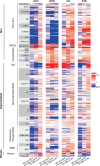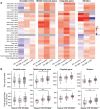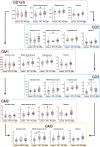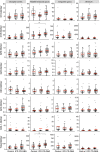Elevation of gangliosides in four brain regions from Parkinson's disease patients with a GBA mutation
- PMID: 35933559
- PMCID: PMC9357011
- DOI: 10.1038/s41531-022-00363-2
Elevation of gangliosides in four brain regions from Parkinson's disease patients with a GBA mutation
Abstract
A number of genetic risk factors have been identified over the past decade for Parkinson's Disease (PD), with variants in GBA prominent among them. GBA encodes the lysosomal enzyme that degrades the glycosphingolipid, glucosylceramide (GlcCer), with the activity of this enzyme defective in Gaucher disease. Based on the ill-defined relationship between glycosphingolipid metabolism and PD, we now analyze levels of various lipids by liquid chromatography/electrospray ionization-tandem mass spectrometry in four brain regions from age- and sex-matched patient samples, including idiopathic PD, PD patients with a GBA mutation and compare both to control brains (n = 21 for each group) obtained from individuals who died from a cause unrelated to PD. Of all the glycerolipids, sterols, and (glyco)sphingolipids (251 lipids in total), the only lipid class which showed significant differences were the gangliosides (sialic acid-containing complex glycosphingolipids), which were elevated in 3 of the 4 PD-GBA brain regions. There was no clear correlation between levels of individual gangliosides and the genetic variant in Gaucher disease [9 samples of severe (neuronopathic), 4 samples of mild (non-neuronopathic) GBA variants, and 8 samples with low pathogenicity variants which have a higher risk for development of PD]. Most brain regions, i.e. occipital cortex, cingulate gyrus, and striatum, did not show a statistically significant elevation of GlcCer in PD-GBA. Only one region, the middle temporal gyrus, showed a small, but significant elevation in GlcCer concentration in PD-GBA. We conclude that changes in ganglioside, but not in GlcCer levels, may contribute to the association between PD and GBA mutations.
© 2022. The Author(s).
Conflict of interest statement
The authors declare no competing interests.
Figures








Similar articles
-
Glucosylceramide in cerebrospinal fluid of patients with GBA-associated and idiopathic Parkinson's disease enrolled in PPMI.NPJ Parkinsons Dis. 2021 Nov 22;7(1):102. doi: 10.1038/s41531-021-00241-3. NPJ Parkinsons Dis. 2021. PMID: 34811369 Free PMC article.
-
Reduced sphingolipid hydrolase activities, substrate accumulation and ganglioside decline in Parkinson's disease.Mol Neurodegener. 2019 Nov 8;14(1):40. doi: 10.1186/s13024-019-0339-z. Mol Neurodegener. 2019. PMID: 31703585 Free PMC article.
-
Glucocerebrosidase Mutations Cause Mitochondrial and Lysosomal Dysfunction in Parkinson's Disease: Pathogenesis and Therapeutic Implications.Front Aging Neurosci. 2022 Mar 23;14:851135. doi: 10.3389/fnagi.2022.851135. eCollection 2022. Front Aging Neurosci. 2022. PMID: 35401150 Free PMC article. Review.
-
Cholinergic innervation topography in GBA-associated de novo Parkinson's disease patients.Brain. 2024 Mar 1;147(3):900-910. doi: 10.1093/brain/awad323. Brain. 2024. PMID: 37748026 Free PMC article.
-
GBA mutations, glucosylceramide and Parkinson's disease.Curr Opin Neurobiol. 2022 Feb;72:148-154. doi: 10.1016/j.conb.2021.11.004. Epub 2021 Dec 6. Curr Opin Neurobiol. 2022. PMID: 34883387 Review.
Cited by
-
Lack of significant ganglioside changes in Slc17a5 heterozygous mice: Relevance to FSASD and Parkinson's disease.Biochem Biophys Rep. 2025 Mar 14;42:101979. doi: 10.1016/j.bbrep.2025.101979. eCollection 2025 Jun. Biochem Biophys Rep. 2025. PMID: 40144541 Free PMC article.
-
Glucocerebrosidase activity and lipid levels are related to protein pathologies in Parkinson's disease.NPJ Parkinsons Dis. 2023 May 11;9(1):74. doi: 10.1038/s41531-023-00517-w. NPJ Parkinsons Dis. 2023. PMID: 37169750 Free PMC article.
-
APOE3-R136S mutation confers resilience against tau pathology via cGAS-STING-IFN inhibition.bioRxiv [Preprint]. 2025 Jan 12:2024.04.25.591140. doi: 10.1101/2024.04.25.591140. bioRxiv. 2025. Update in: Immunity. 2025 Aug 12;58(8):1931-1947.e9. doi: 10.1016/j.immuni.2025.05.023. PMID: 38712164 Free PMC article. Updated. Preprint.
-
A survey of detection of Parkinson's disease using artificial intelligence models with multiple modalities and various data preprocessing techniques.J Educ Health Promot. 2024 Oct 28;13:388. doi: 10.4103/jehp.jehp_1777_23. eCollection 2024. J Educ Health Promot. 2024. PMID: 39703622 Free PMC article. Review.
-
Gaucher disease provides a unique window into Parkinson disease pathogenesis.Nat Rev Neurol. 2024 Sep;20(9):526-540. doi: 10.1038/s41582-024-00999-z. Epub 2024 Aug 6. Nat Rev Neurol. 2024. PMID: 39107435 Review.
References
Grants and funding
LinkOut - more resources
Full Text Sources
Miscellaneous

